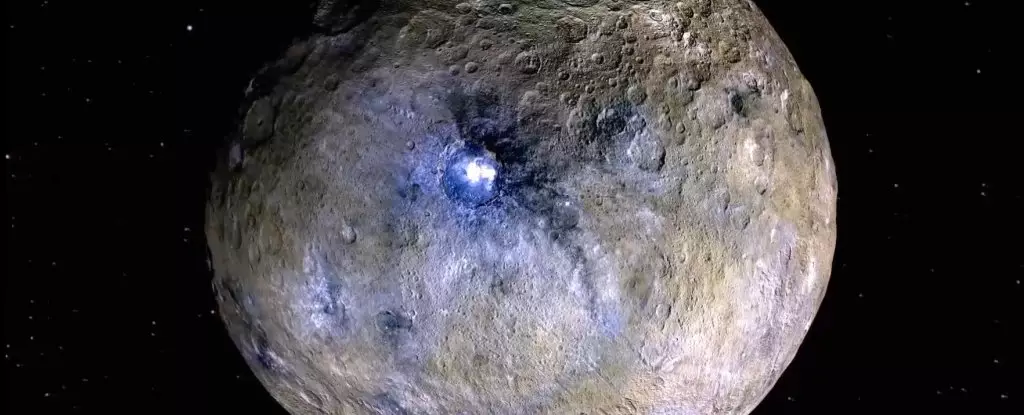Deep within our Solar System lies Ceres, a dwarf planet that has long piqued the interest of astronomers and planetary scientists alike. Located in the asteroid belt between Mars and Jupiter, Ceres is often considered an asteroid due to its location. However, its unique characteristics and significant size—approximately half that of Pluto—grant it a distinct status as a dwarf planet. Recent studies suggest that this celestial body may harbor secrets that could reshape our understanding of icy worlds.
Ceres was first identified in 1801 and has since evolved from a mere curiosity to a focal point in the study of planetary science. Notably, Ceres is the only dwarf planet closer to the Sun than Neptune, sporting a surface marked by bright spots that have been hypothesized to indicate the presence of ice volcanoes. These bright spots have stirred fascination, hinting at the potential for subsurface water ice which could offer insights into the processes shaping icy bodies throughout the Solar System.
Initial estimates regarding Ceres’ surface composition suggested that it may consist of around 30 percent water ice, based primarily on analysis of its cratered surface. The prevailing belief was that if Ceres were predominantly icy, the craters would gradually deform over geological timescales, leaving a smoother landscape. However, the Dawn spacecraft, launched by NASA in 2007 and operational in the asteroid belt from 2015, brought new data that challenged this understanding.
The Dawn mission revealed well-preserved craters that seemed at odds with the notion that Ceres was a body composed largely of ice. Planetary geophysicist Mike Sori emphasized that previous models underestimated the strength of ice under Ceres’ specific environmental conditions. This miscalculation sparked a re-evaluation of the evolutionary history of Ceres, leading to a hypothesis that it could potentially have a crust made up of over 90 percent water ice.
The findings from the Dawn mission prompted further investigation led by Ian Pamerleau of Purdue University. The team ran simulations that revealed a decisive factor in understanding the structural integrity of ice: the presence of non-ice impurities mixed into the water ice layers. By integrating even a small quantity of rock, the simulations indicated that ice could maintain significant stability over millions of years, thereby preserving well-defined craters.
According to Pamerleau, even solids exhibit a slow flow over long periods. As the simulations demonstrated, craters that maintain their sharp features indicate a dynamic where a high concentration of water ice near the surface transitions to a more rocky composition deeper within. This model aligns well with the observed characteristics of Ceres’ surface and hints at a complex geological history.
If Ceres does indeed host a crust rich in water ice, it opens new avenues for understanding other ocean worlds throughout the Solar System. Several moons, including Europa and Ganymede around Jupiter and Enceladus and Mimas around Saturn, bear icy surfaces over assumed subterranean oceans. These icy moons maintain their liquid interiors through tidal heating created by gravitational interactions with their parent planets.
In stark contrast, Ceres lacks such tidal forces. Researchers propose that if Ceres once had a liquid ocean, it has since frozen over completely, creating a unique environment which may diverge considerably from the icy moons of gas giants. Sori surmises that Ceres may have initially shared characteristics with these ocean worlds but evolved differently due to its unique solar position and lack of tidal heating.
If Ceres is indeed a frozen ocean world, it could reshape our expectations of what such environments might look like beyond the classic models presently observed in the outer Solar System. The thought that a mere dwarf planet could enhance our understanding of extraterrestrial environments is exhilarating for the scientific community.
As the most accessible icy body within our reach, Ceres presents an incredible opportunity for future exploration. NASA’s past missions have unlocked numerous secrets of this dwarf planet, and the potential for new missions aimed at Ceres could uncover even more. Sori advocates for renewed exploration, emphasizing that Ceres could serve as an invaluable comparison point for understanding watery environments elsewhere, especially in the context of finding life beyond Earth.
Ceres is more than a mere speck in the vastness of space; its icy crust and complex geological history hold the promise of unlocking mysteries that could answer age-old questions about the potential for life in our Solar System.


Leave a Reply